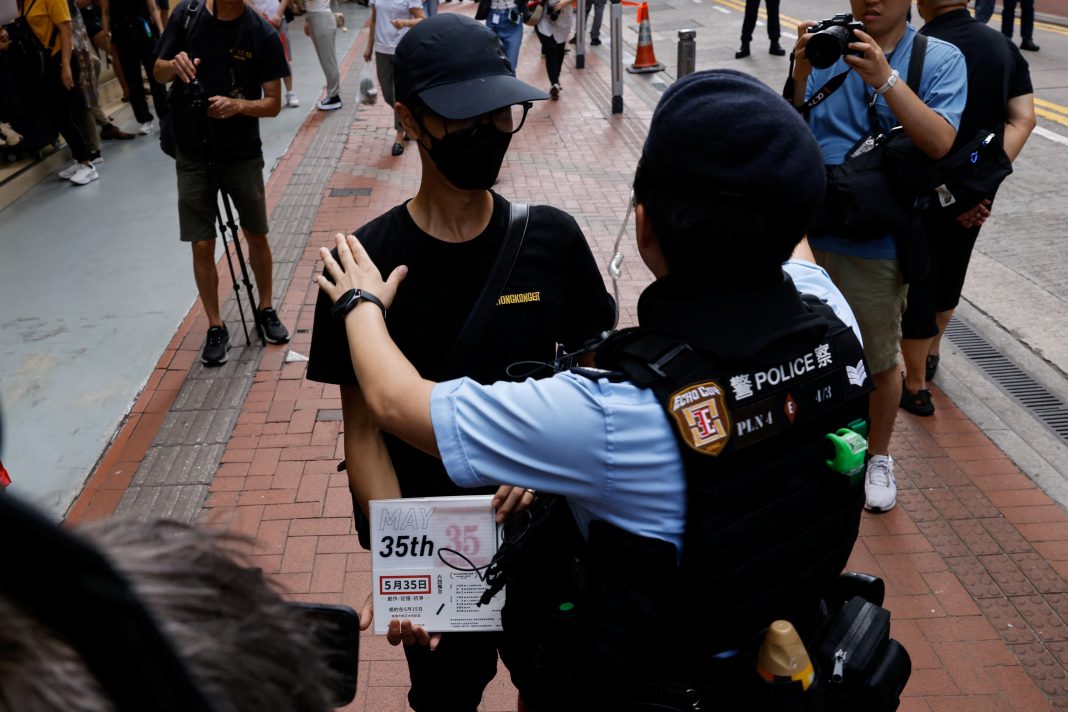On June 4, 2025, police in Hong Kong brought an armoured vehicle, called the “Sabertooth,” into the busy shopping area of Causeway Bay. This move was part of a large security operation marking the 36th anniversary of the Tiananmen Square crackdown.
Heavy Police Presence in Causeway Bay on June 4
The armoured vehicle was seen on Great George Street, an area close to Victoria Park where people used to gather for public candlelight vigils to remember those who died in 1989.
Hundreds of Hong Kong police officers, both in uniform and plainclothes, were placed around Causeway Bay. The Hong Kong MTR station, the Sogo department store, and Victoria Park were all surrounded by officers. A automobile veered onto a pedestrian-only road outside Sogo, prompting the installation of anti-crash barriers by Hong Kong police. The driver was taken away by the police once the car was removed.
The deputy police commissioner for national security, Andrew Kan, was spotted strolling along Causeway Bay in Hong Kong at approximately 5:05 p.m. His visit lasted around 10 minutes. Another senior officer, Keith Yip, deputy commissioner of operations, appeared in Victoria Park around 7:45 p.m.
Some people who tried to mark the day quietly in Hong Kong were approached or taken away by police. A man holding an electric candle in Victoria Park was surrounded and taken away. They also stopped and searched a woman on Great George Street who was carrying a white flower before escorting her to the MTR station. Two more women were removed in a police van, one of whom was carrying flowers and looked like a student.
From Smartphones to Missiles: China’s Rare Minerals Rule Risks Global Tech Slowdown
Several People Taken Away by Police
One well-known activist, Lui Yuk-lin, also known as “Female Long Hair,” was taken away by police after she came out of the MTR station at around 4:28 p.m. She put her palms together in silence before being escorted into a police van. Whether or not she was arrested is unknown.
Chan Mei-tung, a performer, arrived in Causeway Bay at approximately 7:15 p.m. and said she planned to “swim” in Victoria Park. It was raining at the time. She was stopped by police and taken into a van around 7:29 p.m. A day earlier, plainclothes officers had stopped her outside Sogo while she was chewing bubble gum.
In another incident, police approached a man in Victoria Park who was wearing a white cap and a T-shirt with a Chinese slogan and a drawing of the Goddess of Democracy. He was also taken into a van. Around 9:00 p.m., another man wearing a shirt that said “Core Values of Socialism” was led away by police. He had also been taken away the previous year during the same anniversary.
Later that evening, a man with headphones showing the phrase “Hong Kong Add Oil” was stopped near Fashion Walk and taken into a van. His dog wore a yellow ribbon collar with the word “persist” in Chinese.
Police questioned two female journalists who were filming outside the H&M store. One worked for Yahoo News and the other for local news outlet The Collective. They said they showed their press IDs, and police recorded their details before letting them go.
Is There a Hidden Kill Switch in the F-35? China’s Rare Earth Monopoly Raises Red Flags
Changes in Public Memorials and Police Response
For years, Hong Kong was the only city in China, apart from Macau, where public gatherings to remember the Tiananmen crackdown were allowed. Tens of thousands of people come in Victoria Park each year on June 4th to hold candles. This changed in 2020 when the government banned the vigil, citing Covid-19 concerns. The ban continued in 2021, just a year after China’s national security law was enforced in Hong Kong.
The group that used to organize the vigil, the Hong Kong Alliance in Support of Patriotic Democratic Movements of China, disbanded after several of its leaders were charged under the national security law. One of the group’s former leaders, Chow Hang-tung, who is currently detained and awaiting trial, began a 36-hour hunger strike in prison on June 4. A post shared on her Patreon account said that everyone has their own way to remember the day.
Some citizens still tried to mark the day in peaceful ways. In Mong Kok, a pro-democracy shop called AsOne Store gave away digital candles wrapped in labels that read “Tiananmen Mothers.” This term refers to families whose loved ones died in the 1989 crackdown. The shop’s owner, Derek Chu, said more than 20 people had visited the store to collect candles. The store has done this for three years in a row, even after the public vigils stopped.
The day before the anniversary, Hong Kong customs officials checked out another store that sold comparable candles. On Wednesday, local media reported that police officers were dropped from a helicopter onto Lion Rock, a mountain where past banners about the Tiananmen incident were seen. The officers reportedly set up a camp there.
In an official reply to media questions, the police said they could not share specific details about their operations because it might affect the effectiveness of their work.
The crackdown in Tiananmen Square took place on June 4, 1989. Chinese troops and tanks moved into Beijing to end student-led protests. It is believed that hundreds or even thousands of people died, though the exact number is still not known. The topic remains sensitive in China, where discussion or remembrance of the event is usually suppressed.

